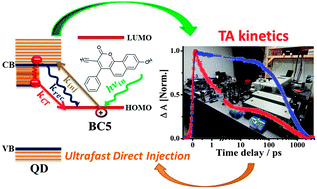Femtosecond insights into direct electron injection in dye anchored ZnO QDs following charge transfer excitation†
Abstract
The role of the charge transfer (CT) state in interfacial electron transfer in dye-sensitized semiconductor nanocrystals is still poorly understood. To address this problem, femtosecond transient absorption (TA) spectroscopy is used as a probe to investigate the electron injection across a newly synthesized coumarin dye (8-hydroxy-2-oxo-4-phenyl-2 benzo[h]chromene-3-carbonitrile, coded BC5) and ZnO quantum dots (QDs). Steady state and time-resolved spectroscopic measurements reveal that BC5 dye interacts strongly with ZnO QDs in the ground state forming a CT complex. The BC5–ZnO QD complex absorbs more towards red compared to only the dye and QDs, and emits fluorescence due to radiative recombination of photogenerated charges. The formation of charges following the excitation of the CT complex has been demonstrated by observing the signature of dye radical cations and electrons in the conduction band (CB) of the QDs in the TA spectra. The TA signals of these charges grow sharply as a result of ultrafast direct electron injection into the QD. We have monitored the complete dynamics of photogenerated charges by measuring the TA signals of the charges up to a couple of nanoseconds. The injected electrons that are free or shallowly trapped recombine with a time constant of 625 fs, whereas deeply trapped electrons disappear slowly (526 ps) via radiative recombination. Furthermore, theoretical studies based on ab initio calculations have been carried out to complement the experimental findings.



 Please wait while we load your content...
Please wait while we load your content...